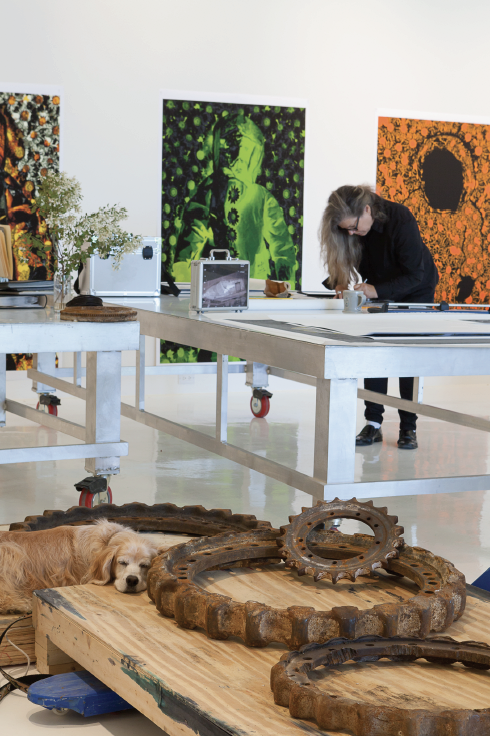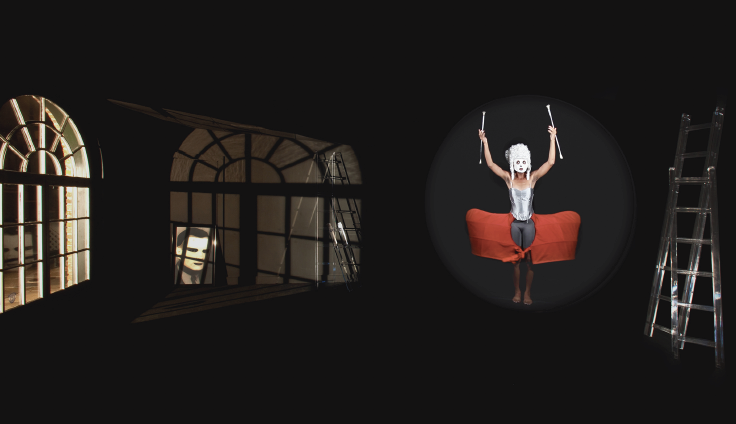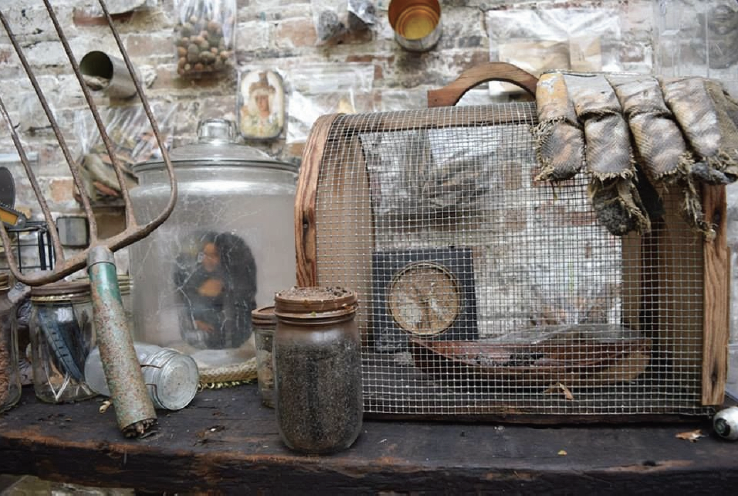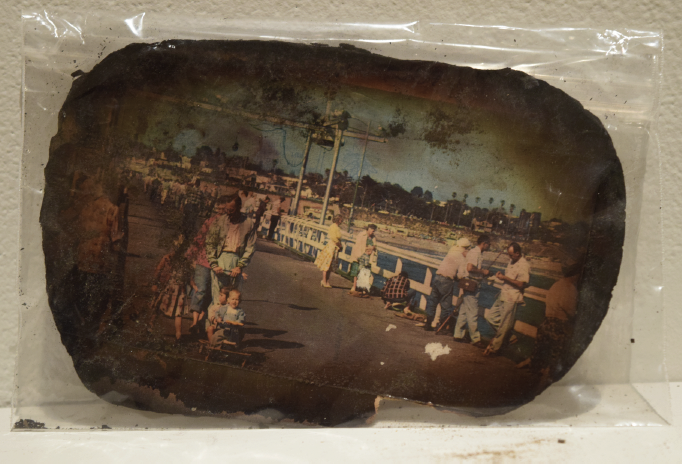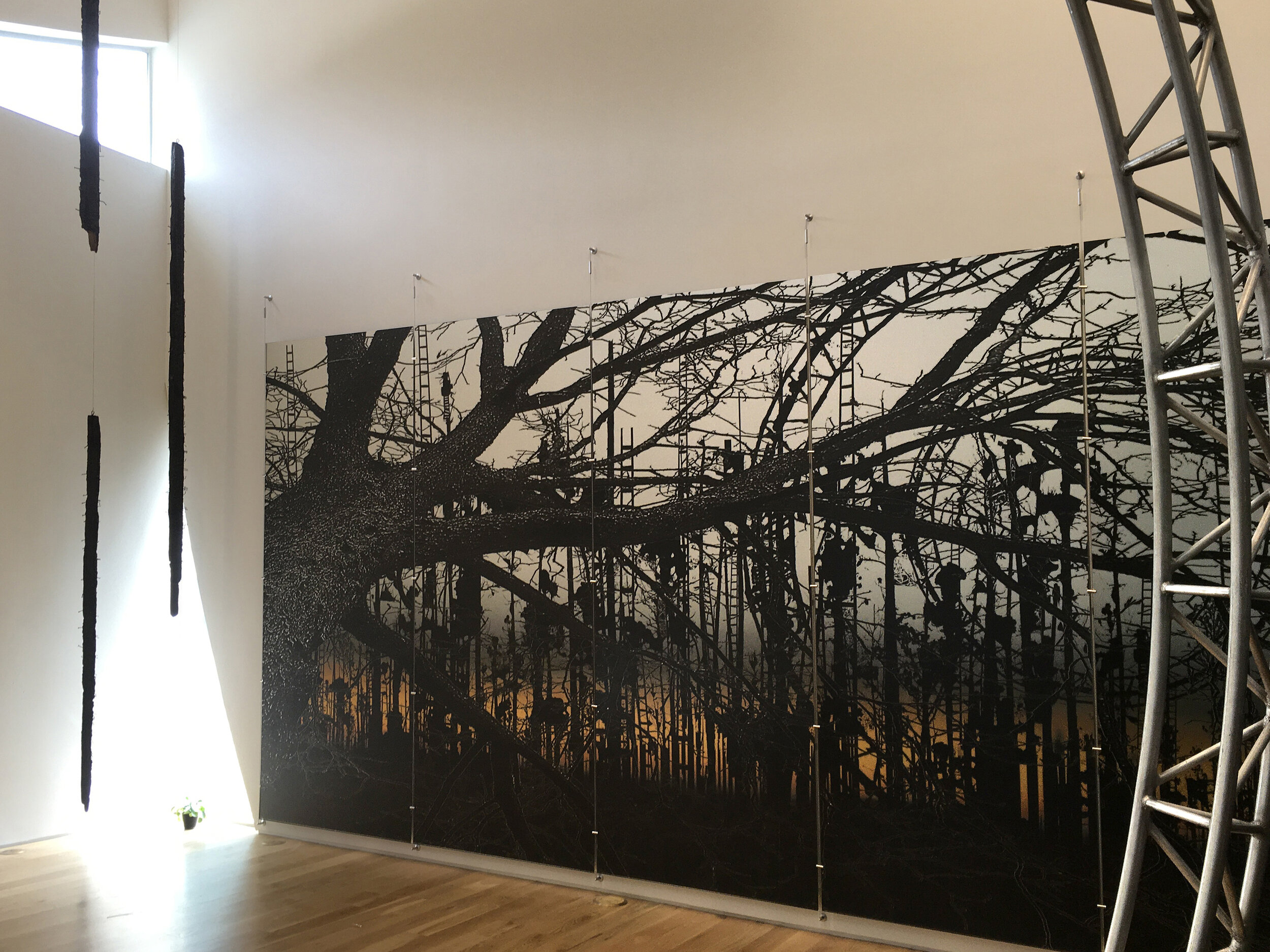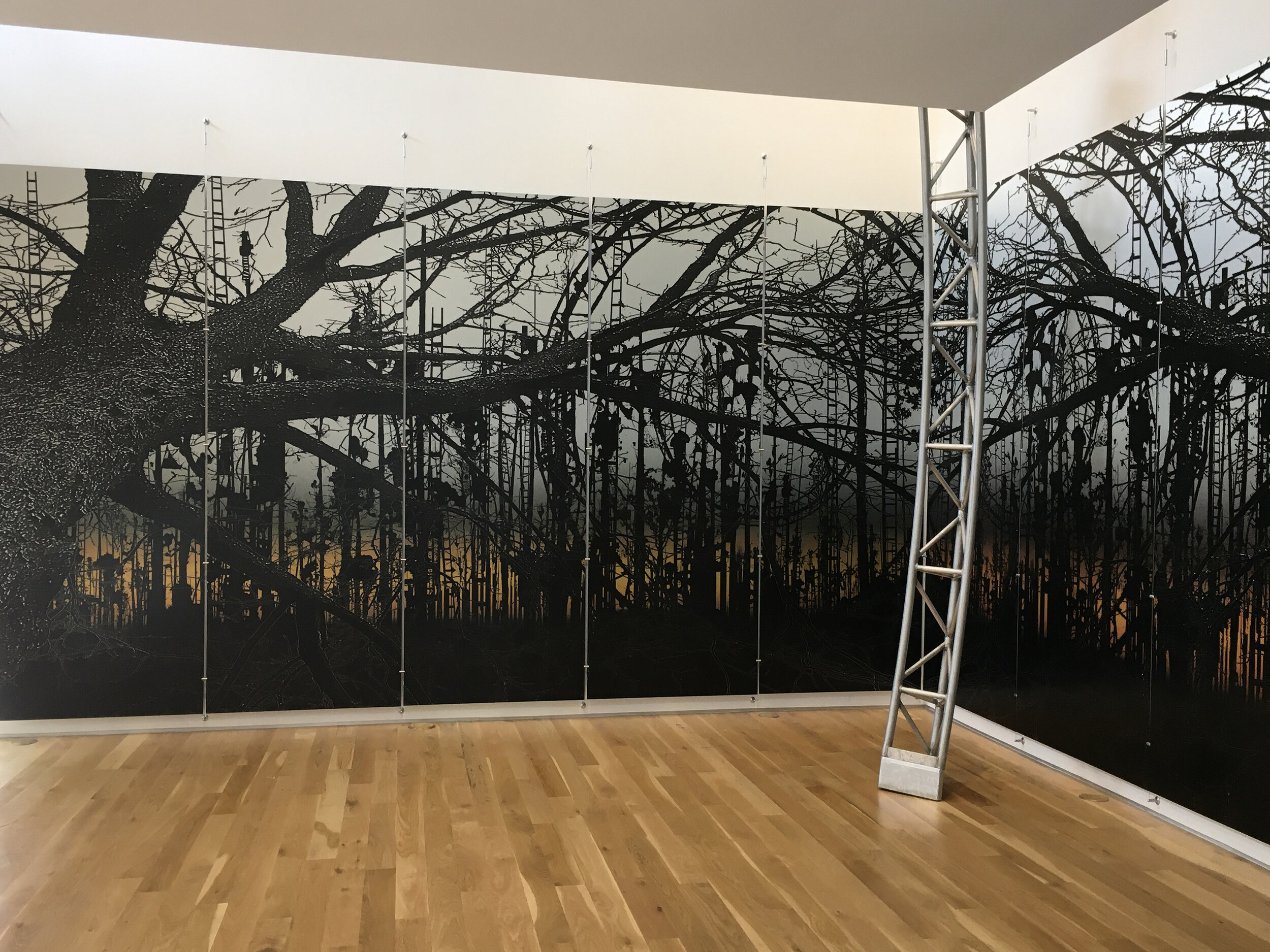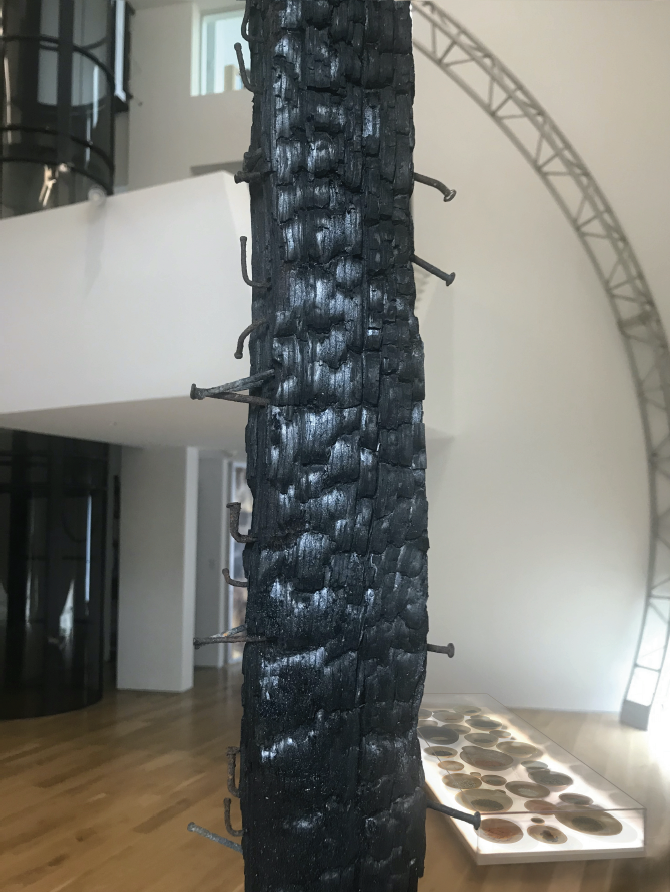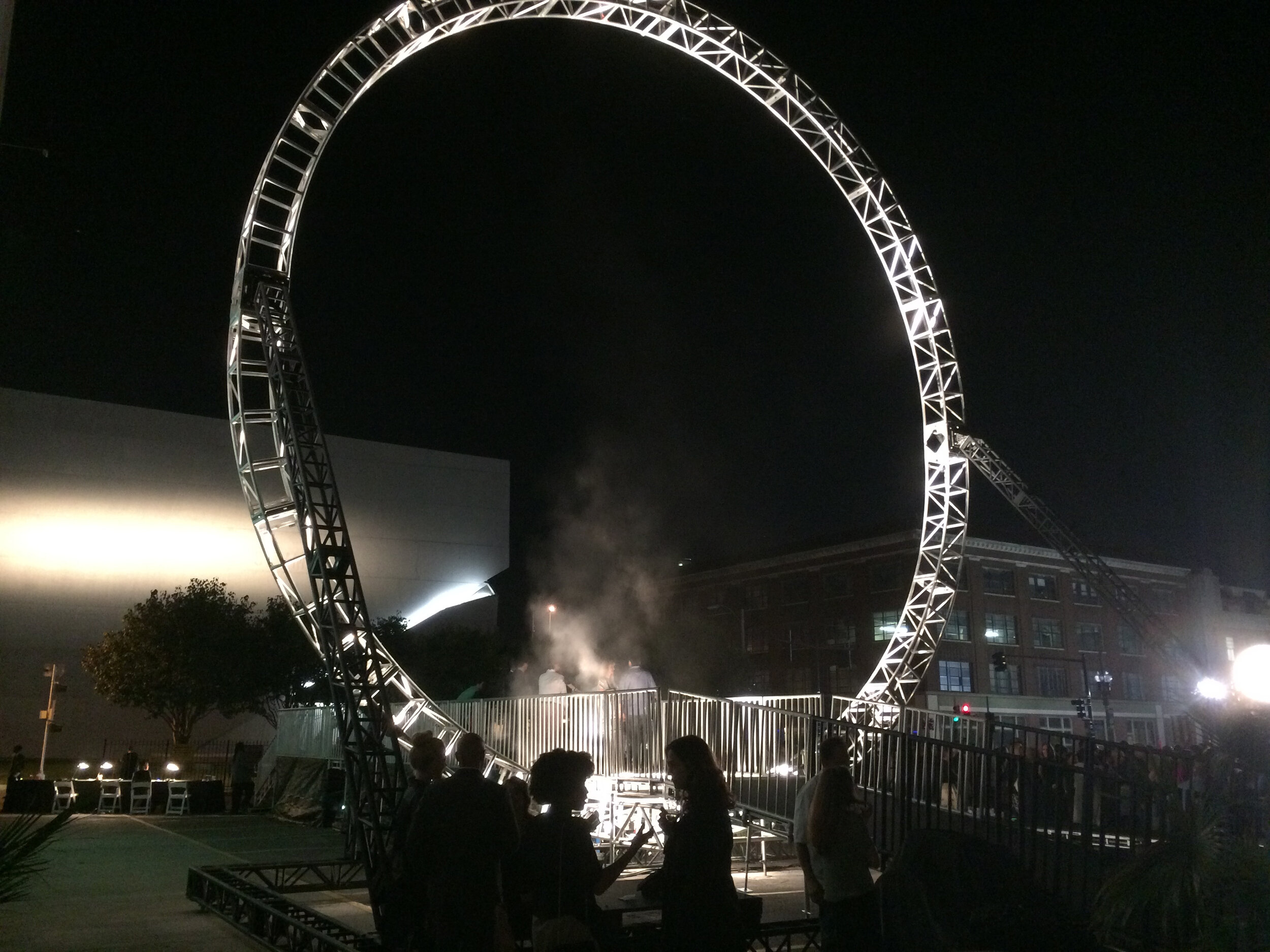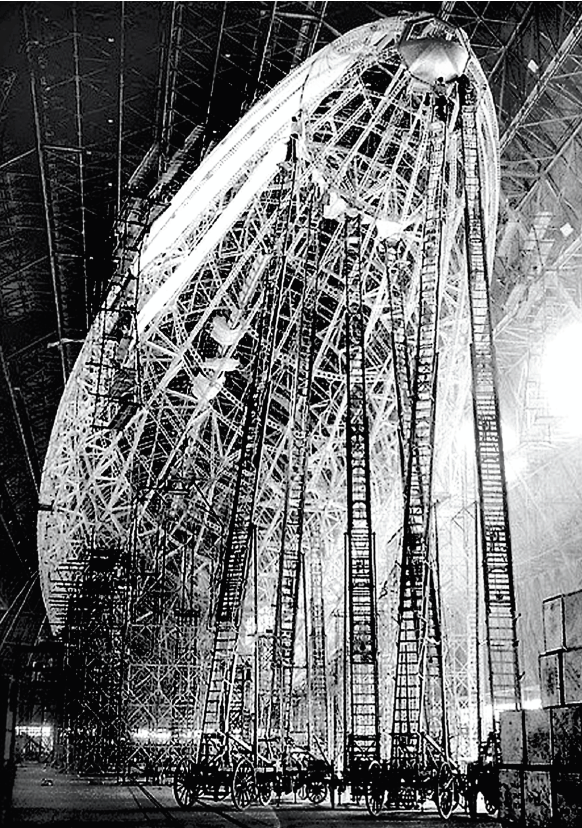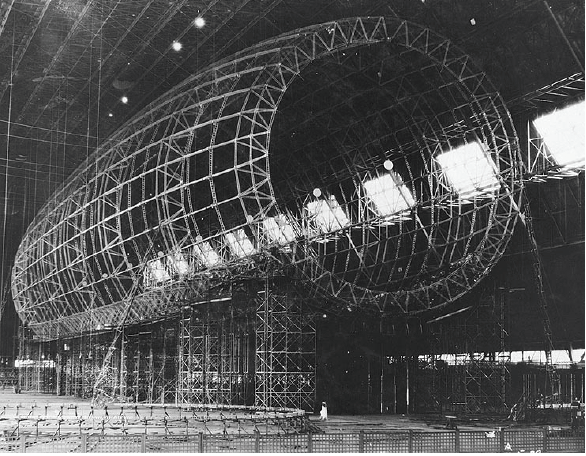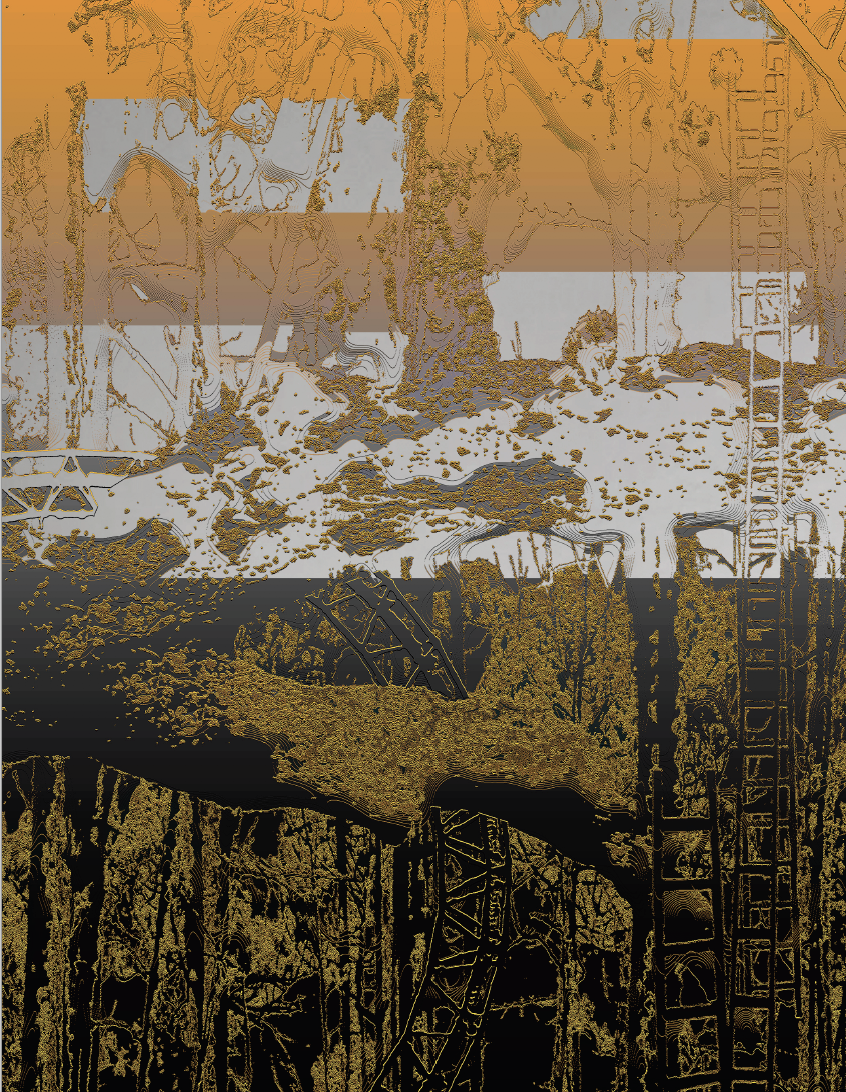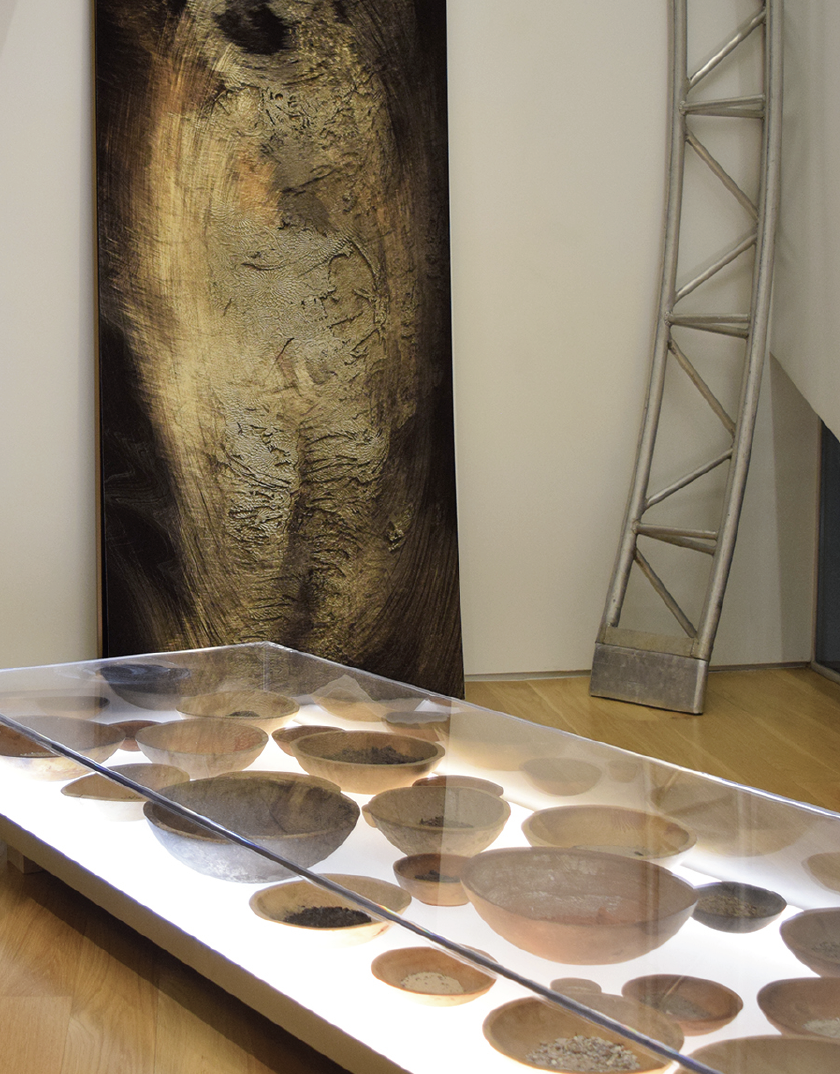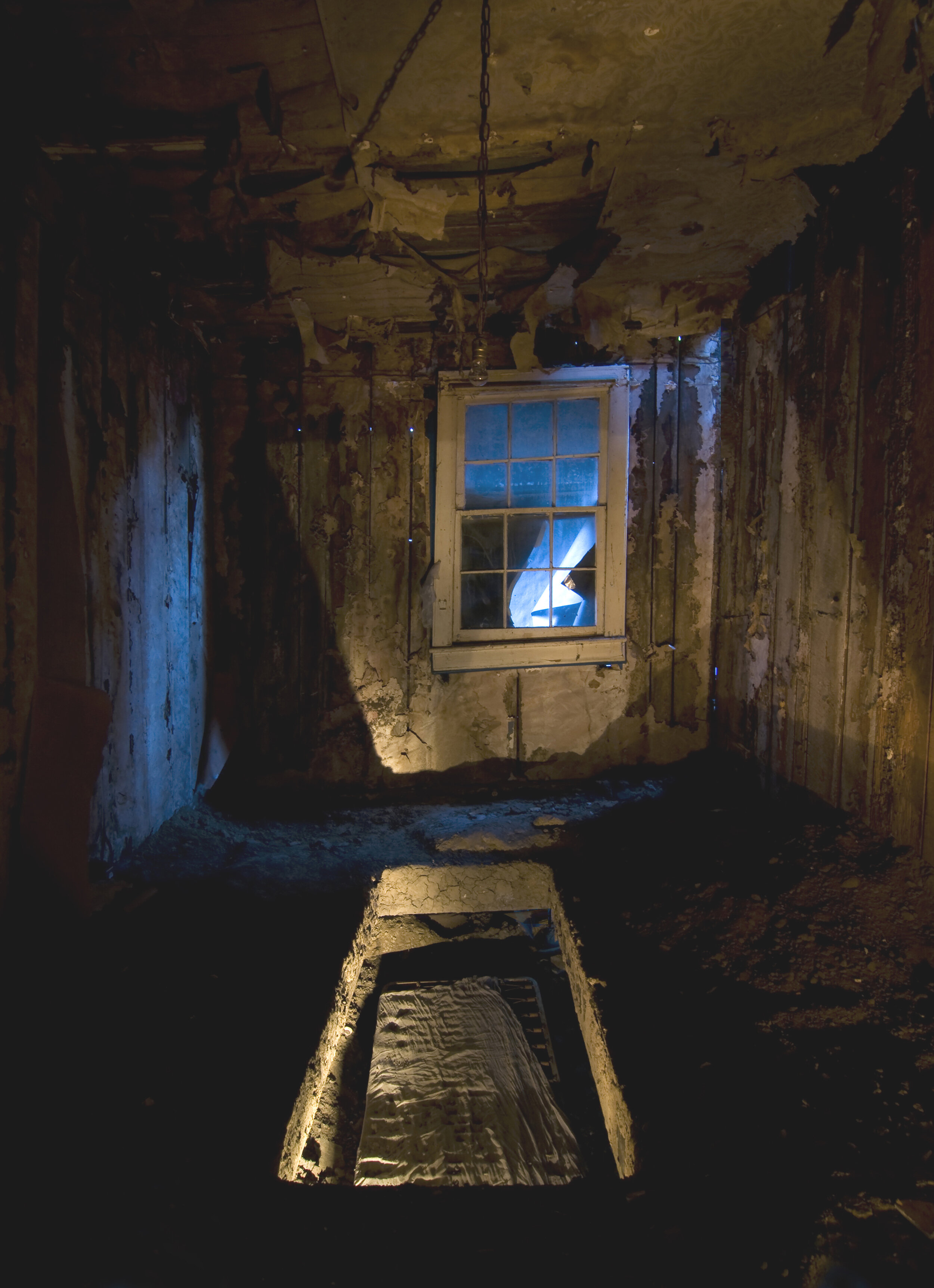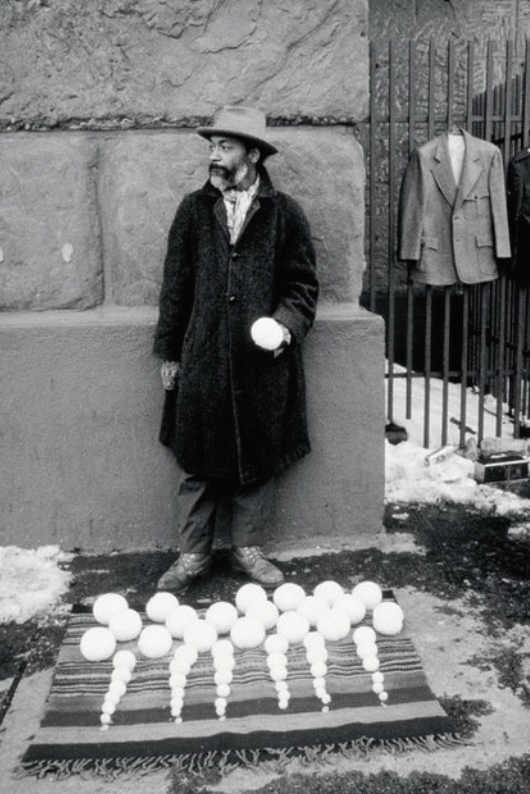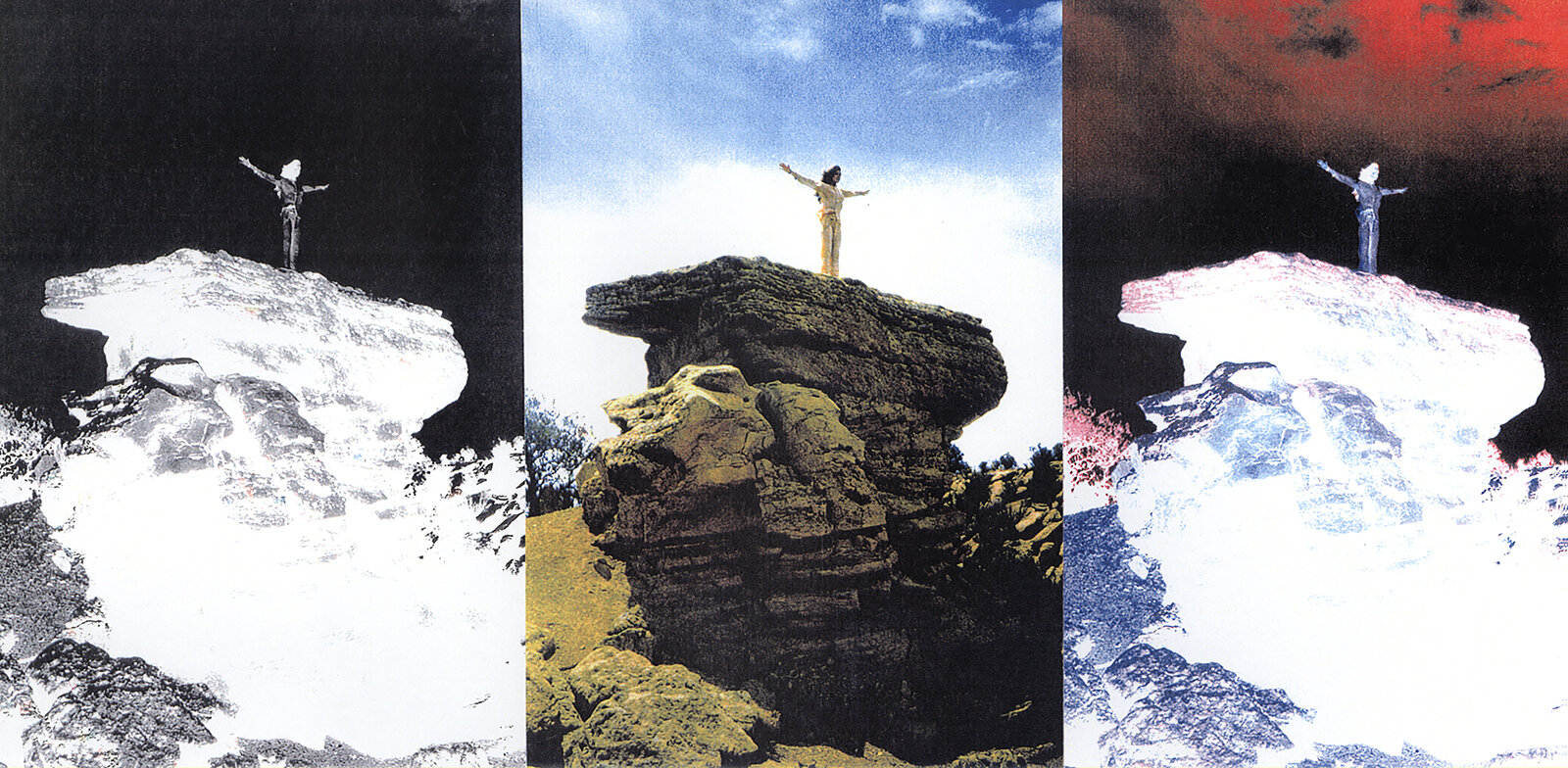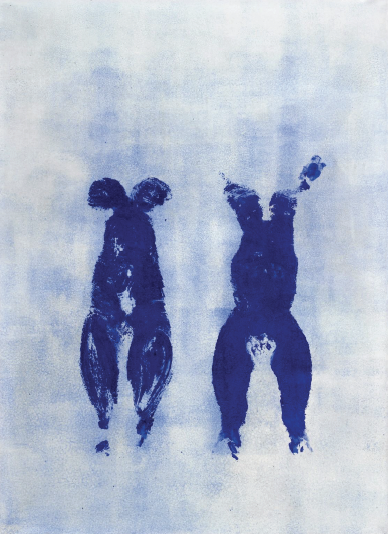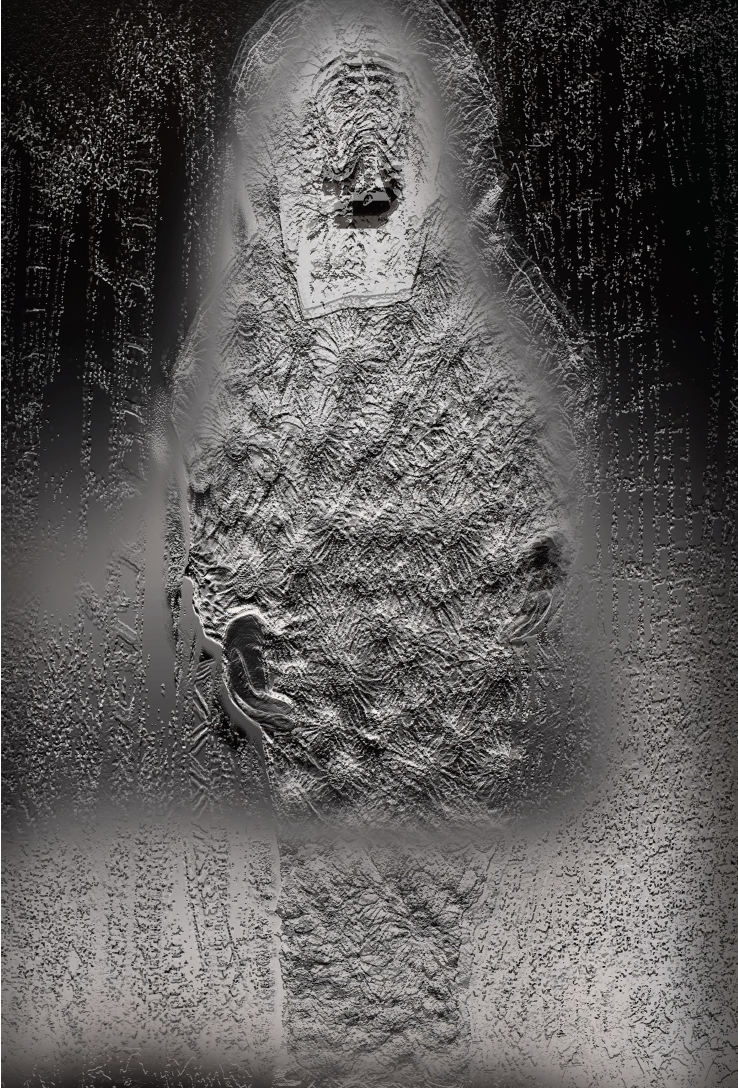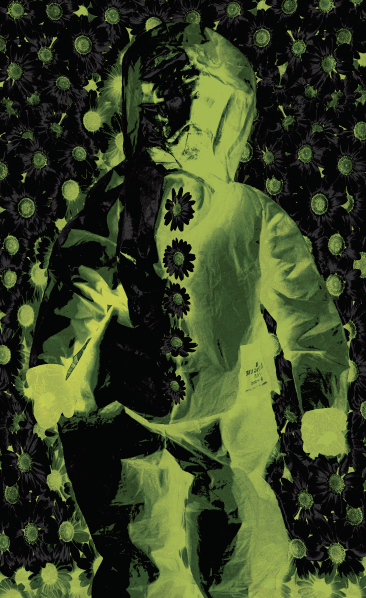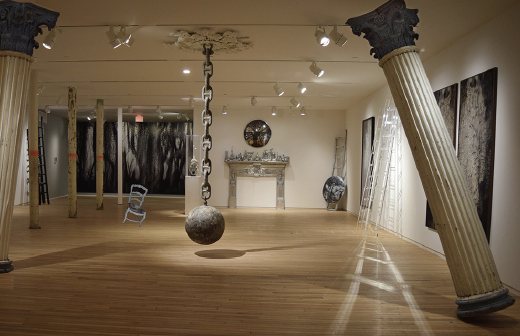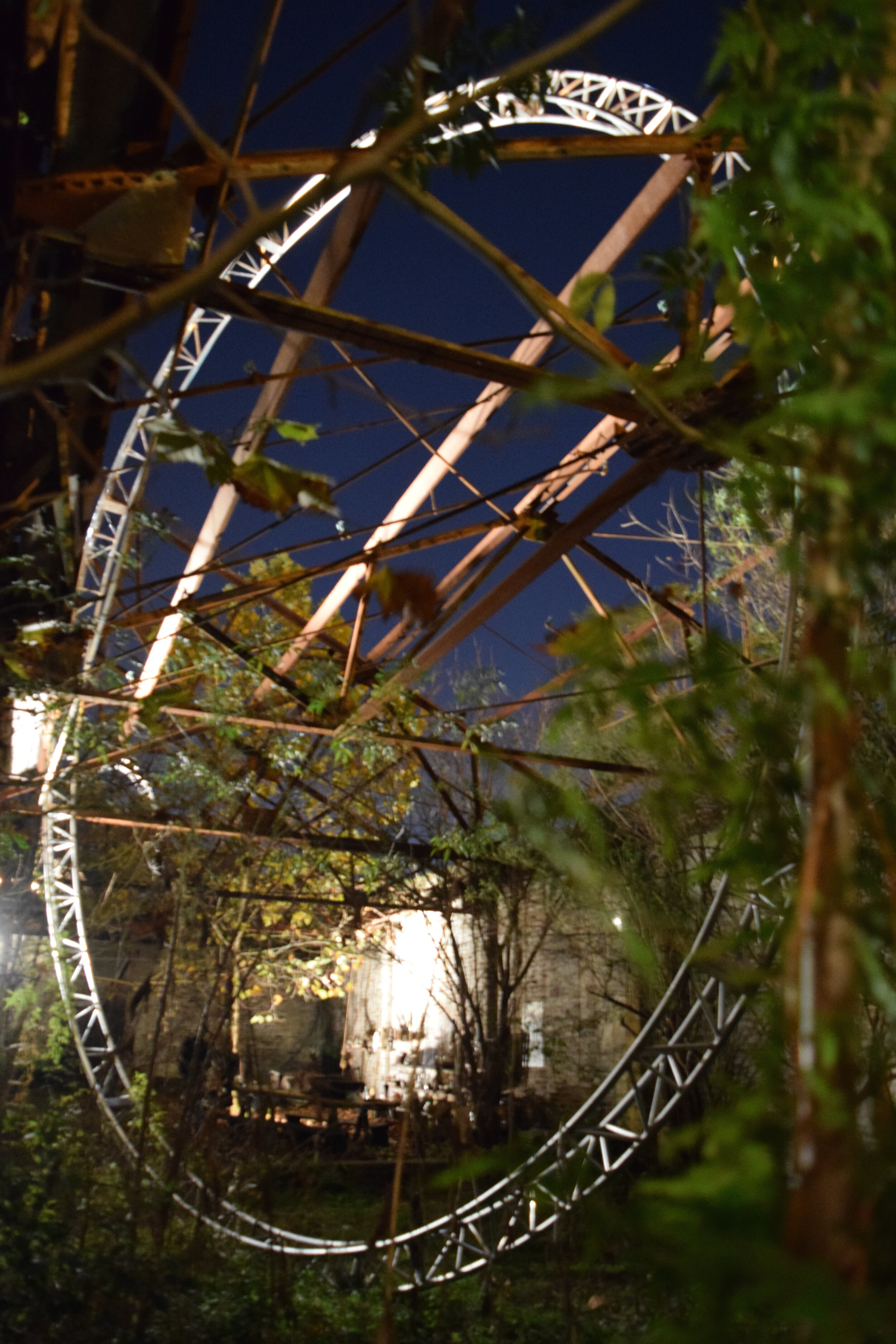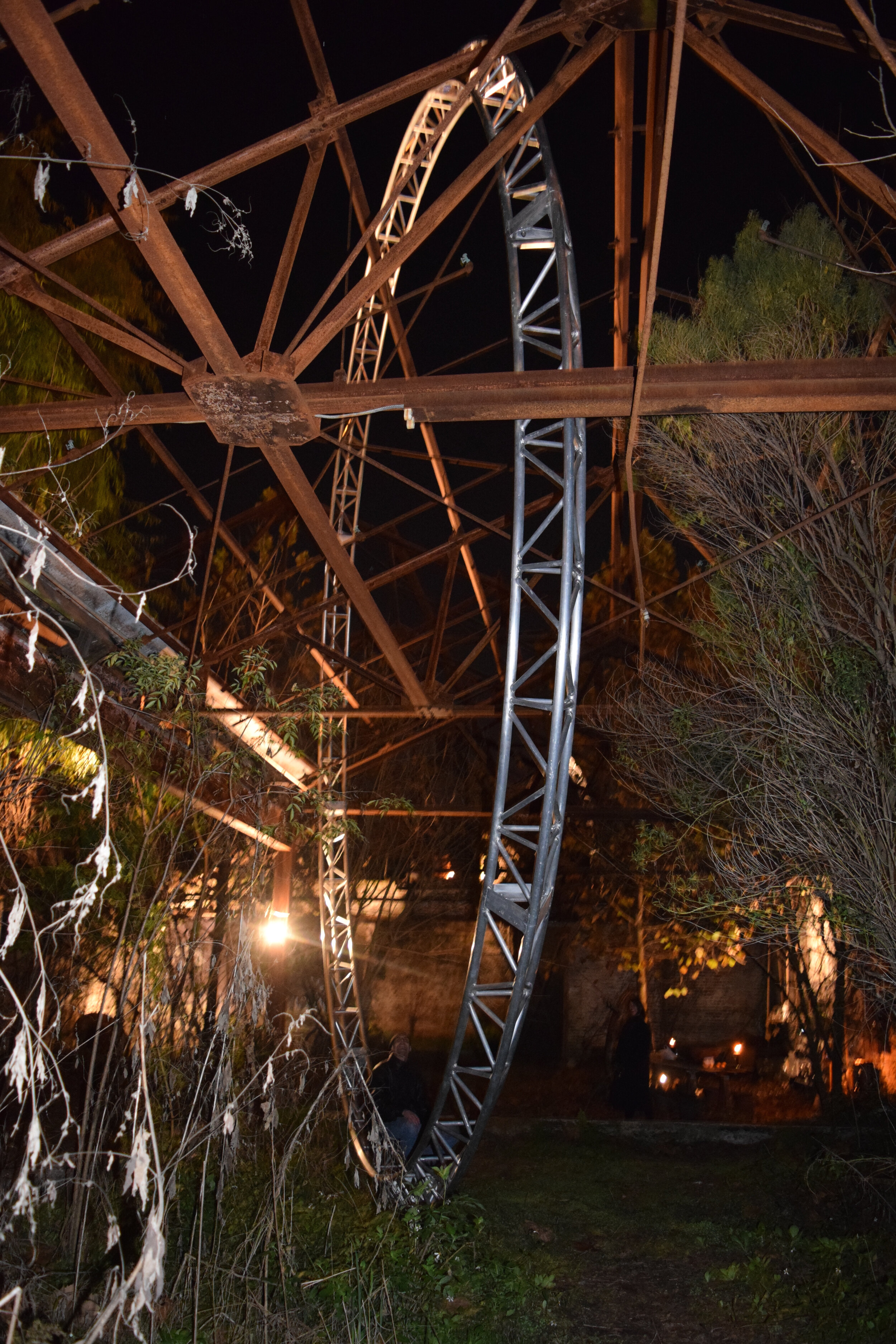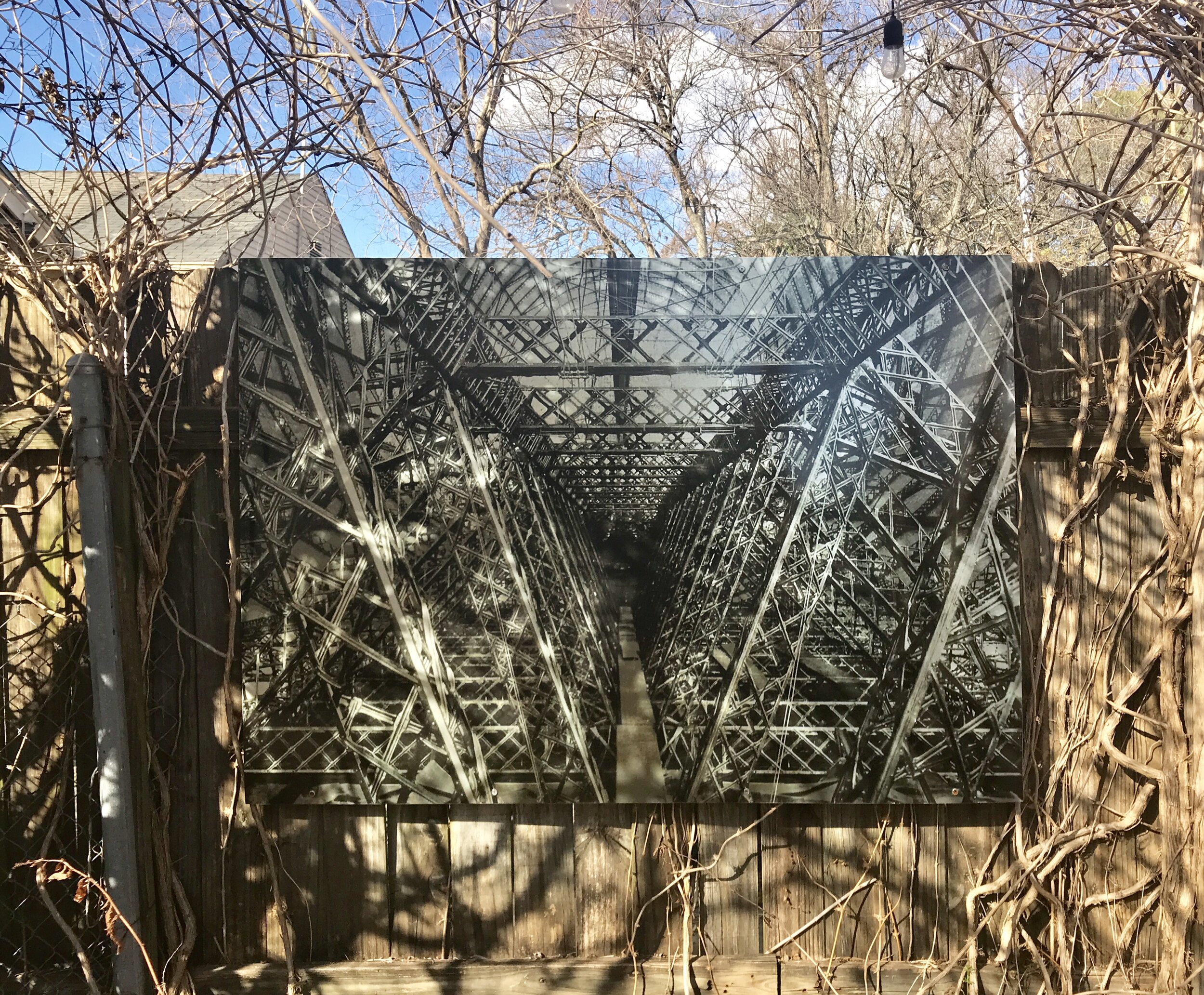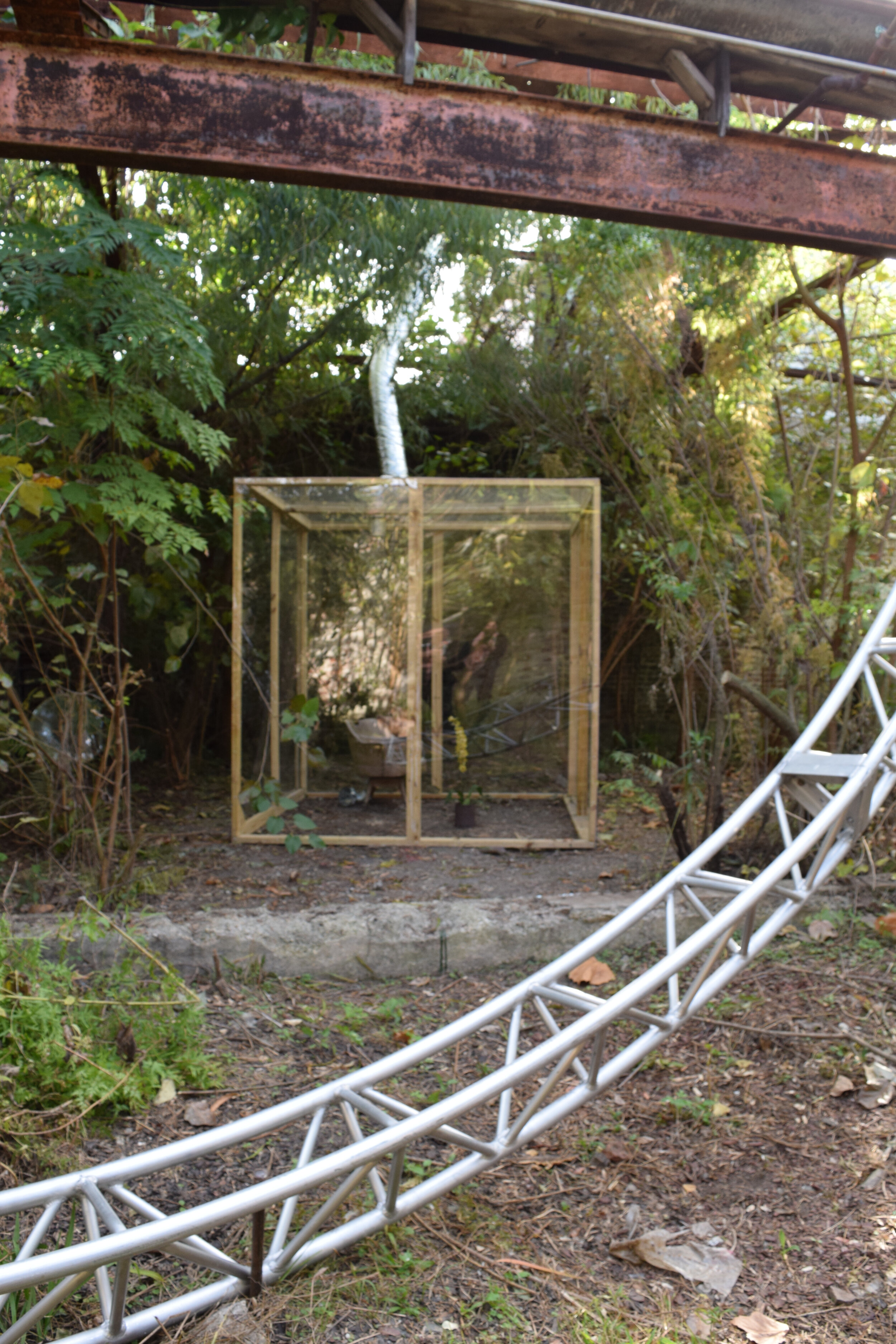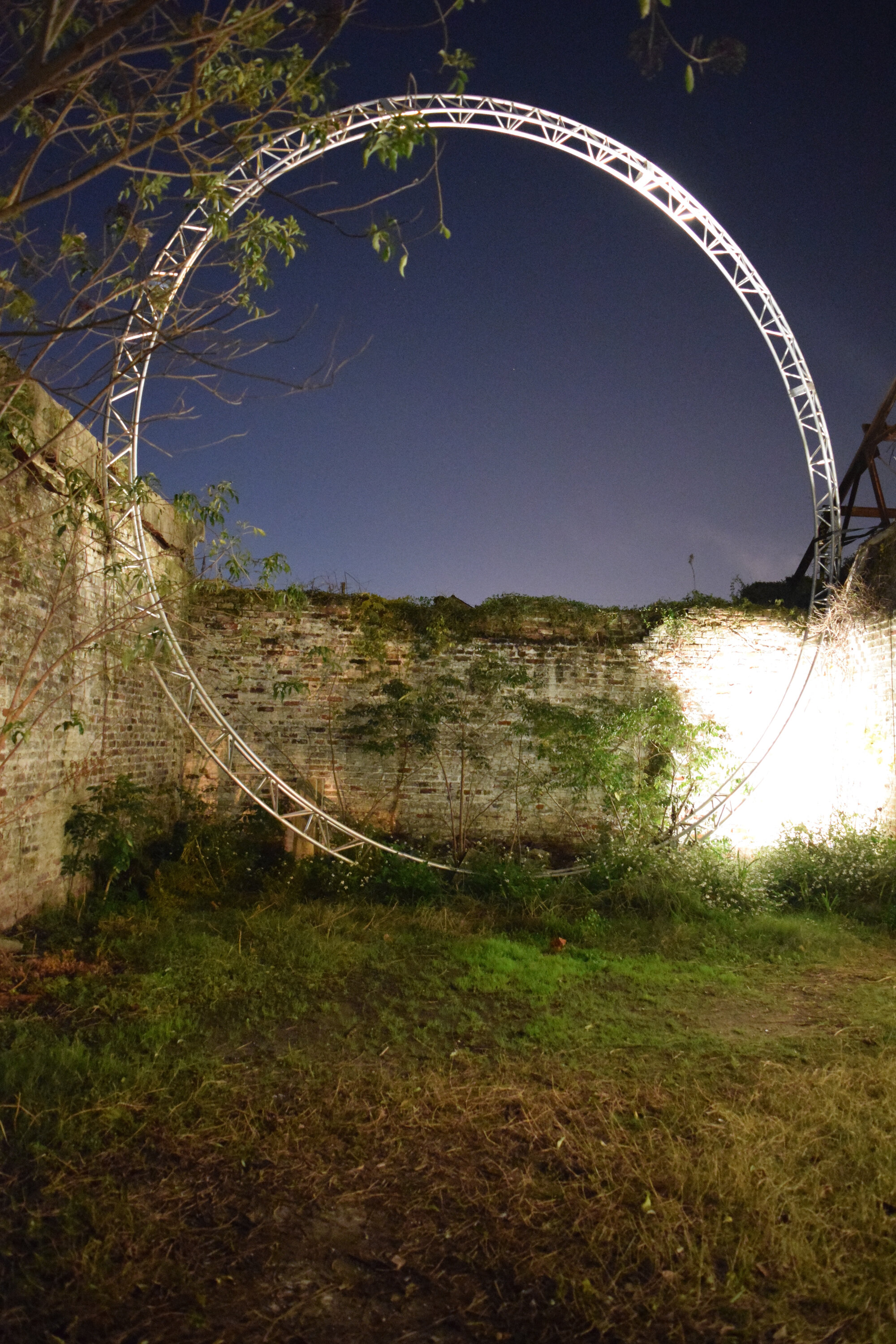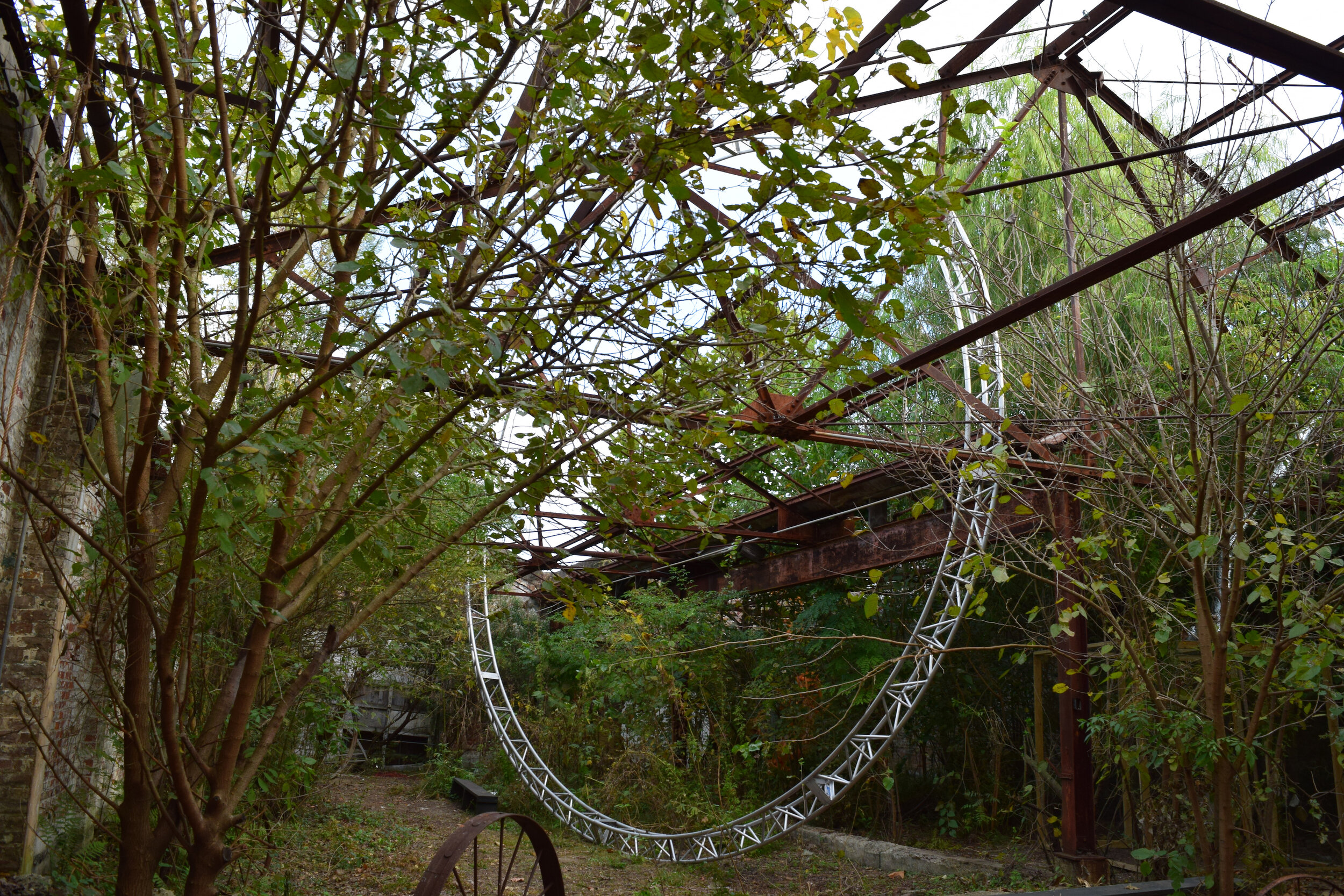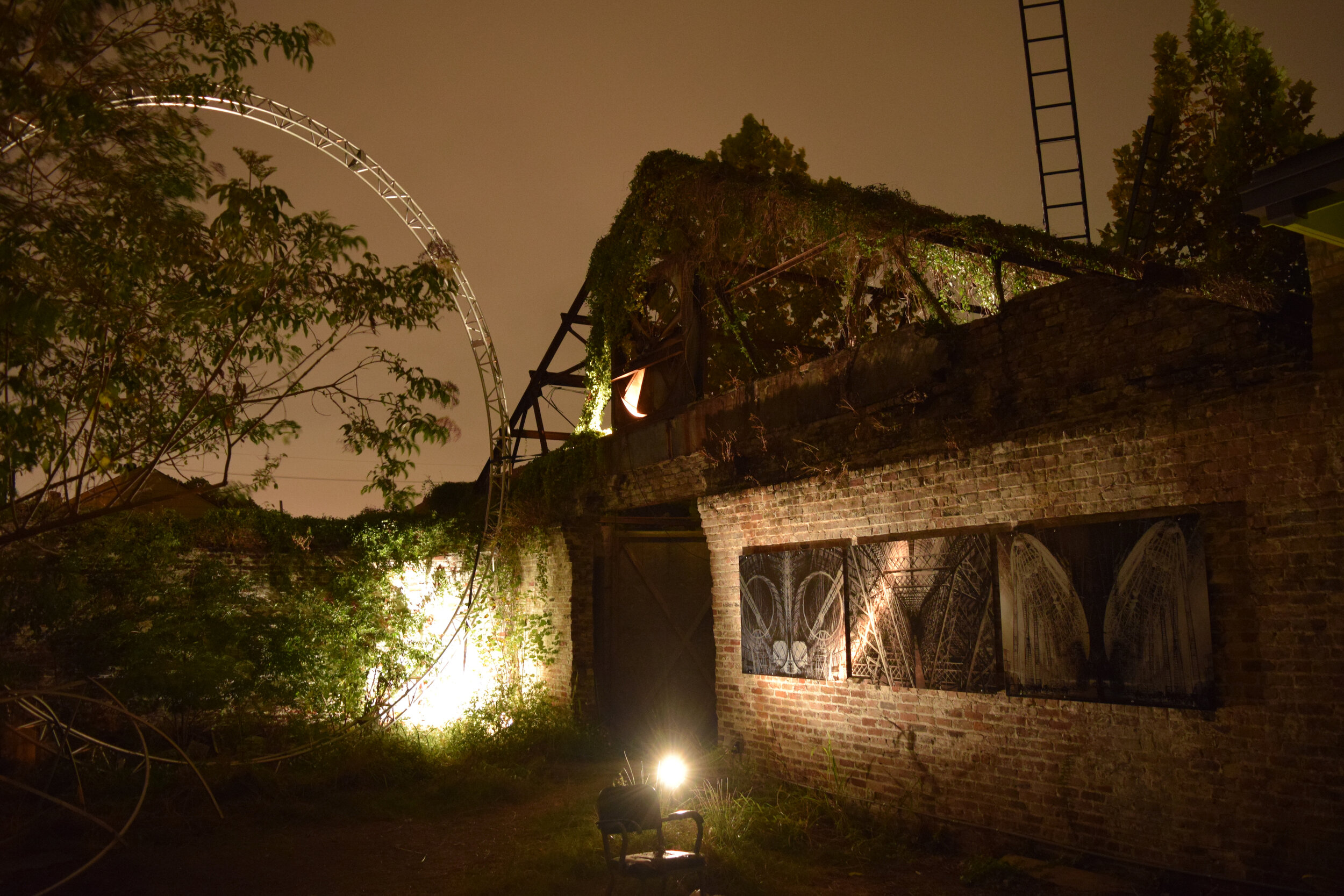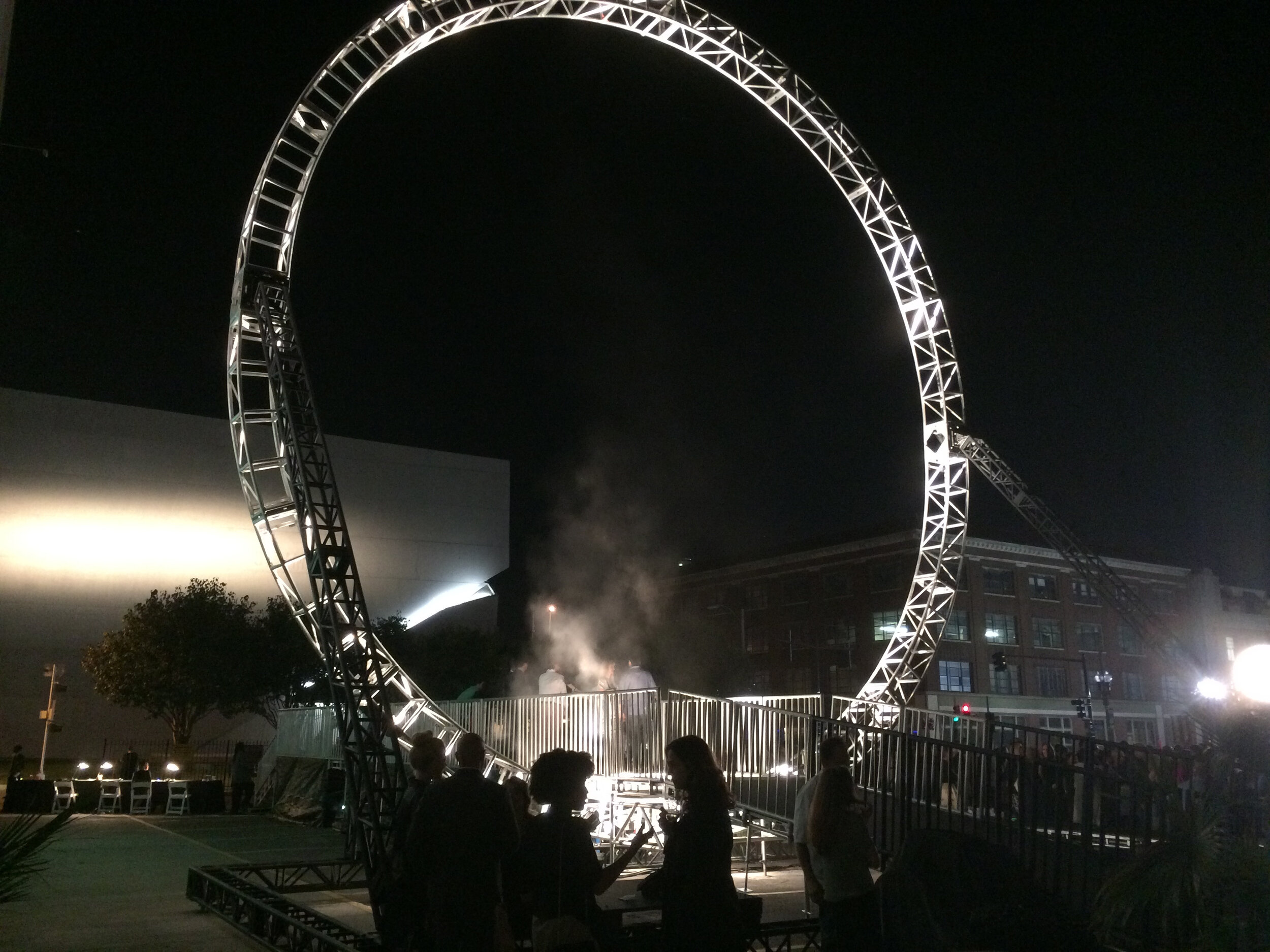BEING AND EVERYTHING: Works by Dawn DeDeaux
Nov 1, 2020 to Jun 21, 2021
The Transart Foundation for Art and Anthropology
1412 W Alabama St, Houston, TX 77006
By appointment until further notice. Call 713 805-4207 to schedule a visit.
Zeppelin Flight over Pyramids / DeDeaux assemblage from public domain images
Gulf and Galaxy (2005-20) / Detail View / Floor Installation by Dawn DeDeaux
Gulf and Galaxy (2005-20) / Transart View / Floor Installation by Dawn DeDeaux
One Drop Video installation with broken Ladders, 2010 / Dawn DeDeaux
Tools Loosing Definition, detail view (2020), Dawn DeDeaux
Transart Installation View: Tools Loosing Definition (2020)
My Mother’s Neighbor: Following Katrina, 2005
The Vanquished Series, Returning to Panther and the Stars, Dawn DeDeaux
BEING AND EVERYTHING Works by Dawn DeDeaux
Transart Foundation is honored to present works by Dawn DeDeaux, a nationally recognized artist based in New Orleans. The exhibition Being and Everything includes both new works-in-progress and works from the past fifteen years influenced by cataclysmic events - Hurricane Katrina, the BP Oil Spill and Louisiana’s vanishing coastline, the fastest eroding landmass in the world.
DeDeaux has been at the forefront of envisioning a post-anthropocene world as part of her decade-long MotherShip series — with components recently on view at MassMoCA, and her Space Clowns series featured in the fall 2020 issue of Aperture Magazine. Her work addresses scenarios such as the current pandemic, the impact of environmental conditions on planetary habitats, including survivor suits and gear.
Throughout her six month residency at Transart, DeDeaux will utilize the galleries as a staging lab to complete works for the final rooms in her upcoming Career Retrospective at New Orleans Museum of Art - The Space Between Worlds - opening in the fall 2021 concurrent with the city's international triennial Prospect.5. The retrospective will connect her work from the 1970s with its sharp focus on social justice to her later works that place environmental justice front and center. The exhibition will be accompanied by a comprehensive catalogue by Berlin-based publisher Hatje Cantz.
Art and Space Transart Foundation for Art and Anthropology, established by founding director Surpik Angelini, has supported numerous projects of presentation and research for over 20 years. Located in Houston’s art district across the street and between The Menil Collection and Rothko Chapel on West Alabama Street, Transart’s new stellar headquarters has been praised for its bold architecture. DeDeaux’s art interventions play to the scale and curves of the building’s distinctive design, maximizing its terrestrial and astral vertical space. The upper balconies open additional perspectives of art above and below, as though one is gazing upon a distressed Earth through a spaceship’s window — watching fires, floods, and dust bowls from a spinning galaxy.
Material and Matter DeDeaux’s Transart presentation is focused on raw materiality and the elements of earth, water, air, and fire. She utilizes discarded shards of contemporary culture — either digital assemblages of eroding, name-escaping tools, or the residue of dirt, coal, water and glass incorporated in her installations.
Zones The exhibition reinforces the power of Earth's elements in three exhibition zones. The front gallery offers a fire and earth grouping including a 36’ long burning landscape, a low table filled with earth samples from around the world, and a 30’ diameter MotherShip Ring, an evocative portal for escaping a degraded planet.
The rear gallery unites water and air, including an installation of shattered glass illustrating nature’s repeating pattern of vortical motion, a video titled One Drop inspired by the Gulf BP Oil Spill and its global dispersement, and Water Markers that measure the flood heights that frequently inundate vast swaths of neighborhoods in Houston and New Orleans, as well as sea level rise now threatening other cities such as New York, Boston and Miami.
The entrance corridor between the main galleries introduce human presence to the exhibition, with a 12’ wide, semi-translucent panel of rusting tools that have lost purpose and name, together with figurative works from The Vanquished series that portray dematerializing floating bodies as they return to the stardust from which they are made.
Being Everything The exhibition title Being and Everything is inspired by mid-90s works by DeDeaux about historical ironies, where she focused on German philosopher Martin Heiddeger’s Being and Time and its impact on Frenchman Jean Paul Sartre’s subsequent Being and Nothingness (while Germany and France were at war). DeDeaux now updates her journey in a chain of philosophical thought with links to twenty-first century New Materialists and Post Humanists - recognizing, in particular, Jane Bennett’s book Vibrant Matter. Through these new offerings one can still find threads to Heiddeger.
DeDeaux adds, “Today’s discourse recalibrates the measure of ‘all things’ — placing equal value to inanimate materiality with that of living forms. We are placing all the known facets of the universe together into a stew of everything where each component plays its role. Understanding the interdependent relationships heightens our sense of responsibility to the ecosystem and our own vulnerability.”
ABOUT THE WORK: Geological Time In a new interpretation of Gulf and Galaxy (2006 - 2020) DeDeaux hand tossed over a ton of shattered glass onto a backlit floor to illustrate common patterns found in micro and macro systems of the natural world. The structural and mechanical similarity of swirling storm winds atop the Gulf of Mexico and the spinning formation of stars in a galaxy becomes apparent.
Gulf and Galaxy also addresses geological time measured in ripples created by the impact of objects — large or small, pebble or meteor — upon the earth’s surface and rolling throughout the yielding fabric of deep space. DeDeaux offers a ‘ground zero’ strike in the work’s center grid, to acknowledge the Chicxulub Crater impact locale in the Gulf of Mexico off the Yucatan coast — exactly due south from the Texas and Louisiana bordering shores. This miles-wide and miles-deep cavity was made from an asteroid or comet that impacted the Gulf nearly 66 million years ago — causing worldwide climate disruption and mass extinction for 75% of plant and animal species on Earth, including all non-avian dinosaurs. DeDeaux implies that history is likely to repeat itself.
One Drop One Body A 2010 video work titled One Drop features the surface of a glass of water, rippled by the day’s wind, reflecting the sky above. It presents an illusion of a planet, projected onto an orb attached to the upper corner of Transart’s 24’ high ceiling. It is accompanied by a haunting sound track of deep space and actual ambient sounds of the wind and nature from the original audio. At times the orb looks tranquil and then suddenly highly agitated, appearing as though an angry earth.
DeDeaux first created the piece in response to the BP Oil Spill and the chemical Corexit that was used to disperse the oil into droplets. She countered “that while reduced in scale, the oil and the Corexit still remained. It merged with the Gulf Stream - moving over six feet of water every two-seconds — up the eastern shore, across the Atlantic, eventually reaching Greenland and beyond. It’s about cause and effect, and an acknowledgement that pollutants impact the whole — just as each drop of water landing upon the earth from the clouds above or from the springs below finds a common level, becoming a unified body.”
Frail Ascents and Deep Water As remnants of failed escapes to One Drop’s planet, DeDeaux has positioned an array of fabricated ladders with broken rungs beneath the projection. She often applies the ladders in numerous variations as a metaphor of the continuum of past and future time. DeDeaux’s fragile ladders first drew from a medieval motif as a means to climb upward towards the heavens to see into the future, in projects such as The Goddess Fortuna. The ladders persist throughout her MotherShip Series for perilous escapes from fiery landscapes and rising tides.
The threat of flood waters in Texas and Louisiana is signaled on the facing wall in a sculptural series titled Water Markers - thick acrylic slabs of watery image towering above the heads of viewers, creating a visceral underwater experience.
Algama Curator Surpik Angelini states, “DeDeaux embraces an all-encompassing notion of ‘object’ understood as ‘everything’ — an ‘everything’ where, through degradation or transmutation, the causality of all things dissipates into the unknown (such as her shards of glass and de-composing tools). Emerging out of the residue of planetary exile, DeDeaux’s objects are also conceived as a longing, an ‘algama’ (Greek for treasure). Her disintegrating tools call to mind Graham Harman’s construct of an object ‘like a retrovirus’ with a regenerative DNA for reproducing itself — allowing anything and everything to soon be everywhere.”
Tools Fleeing Definition in the Transart entry illustrates this transmutation of objects leaving their forms for somewhere else. Describing the work DeDeaux offers, “I see these tools returning to the alloy from which they are made — the rusted crust and core of planets, meteors and stars — a composite of everything. They complete a cycle of existence.”
Centuries not Seasons In his essay Centuries, Not Seasons: Recent Work by Dawn DeDeaux, poet and critic Roberto Tejada engages in an exchange with DeDeaux’s 2005 essay written for Art in America immediately following the devastation of Hurricane Katrina. Tejada illuminates the shadow of disaster cast upon her work, insisting “her rubble of cultural artifacts, in the long duration of geological time, are to be measured in what she calls ‘centuries, not seasons.’ She excites spaces in which to wonder whether alternate formations and transformations of matter are possible. In her recent work, DeDeaux ironizes with design elements drawn from the human sciences to enable a view into cultural forms of a system so in decline as to be already alien to itself. She prompts us to interrogate what present conditions are necessary to act in reply to what she calls the ‘terrifying and extraordinary’ evidence of existence; and to preempt the immanent ‘sudden cessation of life."
Backstage International Curator Dan Cameron has often worked with Dawn DeDeaux, including her previous installations in Texas at Ballroom Marfa, in New Orleans for Prospect.2, and recently in Kansas City as part of the international arts venue Open Spaces. “As curator in three collaborations with DeDeaux, it was a singular experience each time, not least of all because it enabled me to place myself in the position of the ideal audience member, who also gets to run backstage and witness how the magic is spun.”
“DeDeaux’s skill and facility in employing a matchless range of techniques and formats is almost without comparison, particularly in an artist of her generation. At the risk of overstating the singularity of her approach, the sheer volume of handmade objects, images, light, sounds and moods that she orchestrated in tying together the divergent parts resulted in a number of exemplary finished works that didn’t make the final cut, as there was simply not enough room to install them. With DeDeaux, abundance is never simply a matter of having too much of a good thing, but of exploring and developing every possible permutation of a leitmotif, then engaging in multiple arrangements and edits until the final, composite image slowly settles into a crisp perfection.”
Is Paradise Lost? Dan Cameron notes “DeDeaux sees John Milton’s Paradise Lost as a lens through which to consider the environmental drama from a different angle. In her 2018 Kansas City park installation Free Fall, Milton’s text is inscribed onto columns spiked into the earth at a seeming tumble to illustrate his focus on the forces of ‘free will’ as it defines our destiny. Thus, our stewardship of the natural world would appear to have fallen victim to our incapacity to understand the consequences of human actions. Losing paradise on earth will result from not having exerted sufficient free will to save it.“
This potential failure is reflected in the mis en scene on view at Transart where DeDeaux illustrates her own re-interpretation of Paradise Lost as more a prophecy of our immediate future rather than a mythic tale of our past.
No Place Like Home “The seeds for Paradise Lost began with Dawn DeDeaux’s MotherShip Series” according to Dan Cameron. “Along with so many of her fellow artists and global citizens, DeDeaux has been addressing the growing distress over the impending environmental catastrophe. She has taken her cue from a loose group of scientists who predict we will destroy the planet’s sustainability for human life within the next 100 years. Throughout her decade-long MotherShip Series DeDeaux has visualized Earth’s uninhabitable terrains for this final chapter, assuming it’s too late to reverse the process of humankind’s destruction of its birthplace.”
DeDeaux has been constructing and adding to her own narrative on the future in five sequences of MotherShip presentations that examine the convergence of myths and math to foretell our doomed future including: imagined airships for escape; departure terminals to accommodate mass exodus; fashioned wardrobe and gear to survive both the restraints of outer space and reoccurring pandemics; and a system to manage what few objects passengers may take aboard overpacked airships (in the related project Souvenirs of Earth).
Further narrative appeared in a recent two-year exhibition at MassMoCA curated by Denise Markonish and concludes in Houston with its final stage presented at Transart - Mothership Omega - where she is scribing the story’s end. (For additional information please refer to the accompanying text MotherShip Series Chronology.)
Souvenirs of Earth DeDeaux’s Souvenirs of Earth appeared as an interactive installation in MotherShip III: The Station where visitors brought their own souvenirs that DeDeaux arranged in niches and shelves against the warehouse walls as though an ancient columbarium.
Says Cameron, “These personal, even intimate, everyday objects that space travelers will someday opt to bring with them illustrates how these keepsakes immediately become relics of the irretrievable past. For her installation at MassMoCA she borrowed the props from natural history and archaeology; while in Transart her objects (postcards and tools) abandon classification systems, function and form to join the matrix of the indistinguishable everything.“
Floating Sarcophagi Humanity itself joins DeDeaux’s matrix. Also presented at MassMoCA were figurative works from her final grouping of Space Clowns called The Vanquished. These figures in protective suits seemingly reach their end before our very eyes, dematerializing into splinters as though being pulled into a black hole.
Two works from The Vanquished chapter are on view at Transart. Cameron continues “these Space Clowns depict the hybrid state of human beings floating through outer space, with the clear implication that entire generations in the not-too-distant future might experience this as their ongoing reality.”
“Typical of our species is the compulsion to project an individualized, even customized identity outward toward the rest of the world, so DeDeaux’s vision of spacesuits are adorned in such a way as to occasionally obscure our view of the specific wearer. Crystallized patterns like those glimpsed in snowflakes and lace doilies cover the surface, creating the impression that they are somewhat akin to future mummies, versions of ourselves who won’t require any additional embalming when they expire, as their suits can be converted at the flick of a switch into personalized sarcophagi floating through the eternal night of deep space.”
Rapture Transart’s front gallery features a wide view of DeDeaux’s end of time — a 36’ landscape that wraps the corner of the room to envelop the viewer. It is an apt backdrop for a year gone fully mad with Covid, and a record breaking season of hurricanes and forest fires.
he Day Old Forster Tree Fell into the Ring portrays a rapturous choreography of chaos. A massive tree in the foreground is in a state of fall, while other burnt trees define a horizon line on fire.
From Tree to Coal, a toll for thee Synchronically or coincidentally, DeDeaux’s 2011 digital image of a fallen tree could be seen as a two dimensional rendering of the life-size uprooted tree cast in coal by artists Allora and Calzadilla for their current exhibition The Specters of Noon at the neighboring Menil Collection.
Coal as a substance is also used by DeDeaux within her dirt bowls, and featured as charred remains of timbers suspended from Transart’s ceiling adjacent to the landscape. Titled from John Donne’s verse, A Toll for thee (and me) — she deems the hanging carbon relics to that of chimes commemorating our collective end. These nail-pocked timbers are building studs that are the sole remains of DeDeaux’s 6000 square foot studio burned to the ground in a Katrina-related incident, along with a few unlikely postcards that survived inside a small fire proof box. One burnt-edge postcard, installed on the exhibition’s title wall, is the backside of a Mona Lisa postcard from the Louvre.
TOPOGRAPHIES OF EXPLOSIONS Another landscape titled The End, printed on mirror, reflects the viewer’s upward approach to the 2nd floor. The End delineates the deconstruction of explosion and the movement of mass incineration. Another small landscape titled The Zeptosecond is the image of combustion at the brink. It is installed behind Transart’s translucent black elevator.
RING Omega In most ancient myth or futurist fiction there is a symbolic ring, the alpha and omega union of Time. In its universal offerings, the ring represents a quest for love eternal, life eternal — and who could blame us for the longing of an Earth eternal.
Woven throughout the exposed roof girder of DeDeaux’s MotherShip III: The Station were actual 30’ and 50’ truss rings she described as “the skeletal remains of spaceships that never made it off the ground.” One of the rings is now installed within Transart Foundation’s towering space and others are ‘out to pasture’ within the trees at DeDeaux’s Camp Abundance compound in New Orleans.
Open Seating The truss constructed ring inside Transart is modeled after the rings used to build the world’s largest Zeppelin airships. While the aerodynamics of zeppelins won’t break atmospheric barriers, the fact remains that we will need a huge fleet of galactic buses.
If Stephen Hawking is right, by the year 2045 we will need such a space-bound fleet to save billions of people, starving and struggling to breath. In our heart we know that not everyone gets to climb on board, and a fair lottery for mass exodus is a daunting anticipation. It will likely resemble the current rollout for covid vaccines that will not reach developing countries until 2023.
The question of our time remains the same, as it has traversed through the challenges of civil rights and environmental justice, “Who get's a seat on the bus?"
To Dust The Transart immersive narrative Being and Everything concludes with a low standing, illuminated table that holds over a dozen hand hewn wooden bowls , each containing an earth sample gathered from around the world, charred powdery remains of her former studio, and even a portion of her mother’s cremation ash. A figure from The Vanquished series gazes downward from a wall just behind this Dirt Bowl Table (2020), as though overseeing a final ritual.
Here Today Gone Tomorrow. Curator Dan Cameron conveys “because much of DeDeaux’s work emerges from sets of circumstances, it might be simple for someone who has never experienced DeDeaux’s site-specific works in person to believe the art inherently limited by it ephemerality, as if only an artist’s emphasis on permanence provides the potential for it to be taken seriously. This view overlooks the fact that influential artworks of the past century have long ceased to exist in a physical sense, yet we nonetheless continue to ponder Jean Tinguely’s Machine that Destroys Itself, Carolee Schneemann’s Up To and Including Her Limits, David Hammons’ snowball sale arrangement, and any of Christo and Jean-Claude’s major undertakings, even if we can’t visit them today. In these instances, the deliberate absence of physical objects reflects a gradual transformation in our own aesthetic sensibilities, in which the art resides, haphazardly or not, within the stories we continue to tell each other about the things we have seen, and the ways our experiences have changed us along the way. In the case of DeDeaux’s Transart installation, the degradation of the object is precisely its objective.”
Imprints on Time Transart Director and Curator Surpik Angelini remarks “DeDeaux’s post art re-kindles the relevance of Yves Klein’s art, if seen through a post human, post anthropocene perspective. Klein’s anthropometries, his uncanny human silhouettes in blue, can now be understood as visions inspired by the ghostly shadows of post human scenes on the walls of Hiroshima. Likewise, his announcement of mankind’s future telepathic communication can be taken as a presage of art at the end of time. Through powerful rhizomes such as these, both Klein’s figurative shadows and DeDeaux’s dematerializing figures that vaporize into the void of outer space can be joined through communicating vessels, transcending the years that separate them, as precursors of post art.”
A Last Embrace Noted cultural anthropologist Debbora Battaglia, in response to Transart’s presentation of DeDeaux’s work Being and Everything, shares: “This feels like a pilgrimage site that we share. That last embrace of … it all.”
MotherShip I: Postulations of Myth and Math / Installation view2011-12
MotherShip III: The Station by Dawn DeDeaux
Green Space Clown Floating in Space Poppies, 2012-13, Dawn DeDeaux
MOTHERSHIP SERIES CHRONOLOGY
MotherShip I DeDeaux’s installation MotherShip I: Postulations of Myth and Math was presented in 2011-12 as part of The Future Project where she was paired with Los Angeles artists Kenny Scharf and Tom Lesser to inaugurate the new Center for Living Arts in Mobile, Alabama. Her burnt and flooded landscapes on metal panels first appeared, including the work now on view at Transart. DeDeaux’s landscapes ravaged by fires and floods responded to the decades-old data projecting ferocity of fires and floods would incrementally accelerate around the earth as result to climate change. Forecasts have proven true, with 2020 logging the greatest number of forest fires and hurricanes ever recorded in written history.
MotherShip II MotherShip II: Dreaming of a Future Past followed in 2014 at Acadiana Center for the Arts in Lafayette, LA. Here DeDeaux offered an intimate portrayal of humans trying to adapt and survive the cataclysm. She introduced her Space Clowns series developed during her prior 2013 Rauschenberg Residency in Captiva, Florida, where she photographed emergency first responders in assorted protective gear. These images form both a photography portfolio and were used as studies for her digital drawings with curvilinear organic, ornamental motifs to characterize our lament and nostalgia for Earth.
MotherShip III MotherShip III: The Station, was an auxiliary venue of Prospect.3 New Orleans and part of her 2014 Artist Residency at Tulane University School of Public Health, at a time when the School was central to the containment of Ebola virus. The residency contributed to the evolution of DeDeaux’s Space Clowns suits that were further imagined for both the survival challenges of outer space and the toxicity of pandemics and biological warfare here on Earth. DeDeaux took MotherShip III outside of museum interiors and placed her installations within a roofless abandoned warehouse building, reclaimed by tall trees that grew throughout the large open-air truss beam canopy. She imagined this feral site as an excavated ruin — a former Terrestrial-bound Flight Depot Station - for emergency travel into outer space. She sets the deportation stage into the year 2045, when an estimated nine billion Earth refugees will be in need of vertical escape. Woven throughout the exposed roof girder of The Station were actual 30’ and 50’ truss rings described as the entry portals to ships or “the skeletal remains of spaceships that never made it off the ground.” The specific truss ring design was used to build the early twentieth-century zeppelins, the largest air ships built to date. One ring is now installed within Transart Foundation’s towering space and other rings are retired, and looped through the trees at DeDeaux’s Camp Abundance compound in New Orleans.
MotherShip IV MotherShip IV selections were recently featured in DeDeaux’s two year exhibition at MassMoCA, Thumbs Up for the MotherShip, where she was paired with the Afro-futurist artist and musician Lonnie Holley. In contrast to prior iterations, Mass MoCA purveyed DeDeaux's more elegiac quality, with particular artistic attention given to her extension of Souvenirs of Earth. These personal, even intimate, everyday objects that space travelers will someday opt to bring with them illustrates how these keepsakes immediately become relics of the irretrievable past. MotherShip Ring Omega Houston’s Transart Foundation for Art and Anthropology is serving as a six month LAB for DeDeaux to complete the MotherShip Series and the final room within her upcoming career retrospective at New Orleans Museum of Art, The Space Between Worlds, opening fall 2021.
Download PDF An Introduction about Dawn DeDeaux’s Exhibition “Being and Everything”: Selected Notes from Contributors Surpik Angelini, Dan Cameron, Dawn DeDeaux and Roberto Tejada. Here
Space Shroud, Digital Drawing on Mirror, 2014, Dawn Dedeaux












